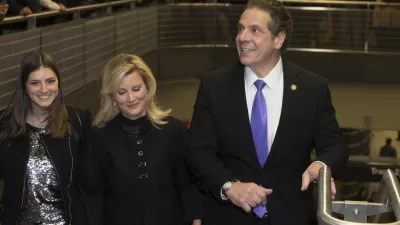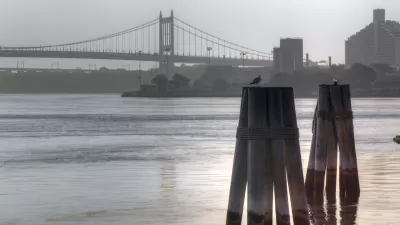Perhaps known more for high tolls than beauty, the Verrazano Narrows bridge turned 50 on November 21. Staten Islanders expected the high tolls to end when the bridge was paid for.
As for the long-held belief by many Staten Islanders that the toll was intended to be temporary, "nobody can seem to find any proof that any such promise was made," writes Yee. "Yet despite repeated debunking, the belief has endured: part cherished urban myth, part rallying cry, vigorously invoked every time the E-ZPass statement arrives or the toll is going up."
The Staten Island Advance has published at least three articles in the past five years in an effort to convince its readers that the toll would never disappear. The newspaper tried, and failed, to put the story to rest once and for all in 2009, when it scoured its archives from before and after the bridge’s opening and found no mentions of a toll-free crossing.
Lee points to another MTA-operated bridge where it was true—tolls were supposed to end "after the bonds used to pay for it were retired."
(T)he Triborough Bridge (now the Robert F. Kennedy Bridge), which connects Manhattan, Queens and the Bronx, built a quarter-century before the Verrazano. But, as Robert A. Caro recounted in his book “The Power Broker,” the Triborough proved too much of a coin cow for Robert Moses, the master planner who midwifed both structures. He had the law amended to let the Triborough Bridge Authority stay in business, and collect tolls indefinitely, by issuing new bonds.
Perhaps the rumor got started before construction with "repeated pleas from a Staten Island politician to reduce fees for the island’s residents" were made, interesting, to Robert Moses, writes Yee. "His Triborough Bridge and Tunnel Authority imposed a 50-cent toll." According to Wikipedia, "(t)he bridge was the last great public works project in New York City overseen by Robert Moses."
"When the Triborough agency was subsumed into the new Metropolitan Transportation Authority, the bridges continued to charge tolls," writes Yee. "They have helped prop up buses, subways and commuter railroads ever since."
Yee goes on to describe attitudes prevalent in "car-dependent Staten Islanders, many of whom did not even want the bridge in the first place, fearing — rightly, as it turned out — that their borough’s quiet would be overrun by newcomers, its rolling farmland bulldozed for new buildings."
Verrazano-Narrows Bridge (and other) Tolls
In addition to a discounted bridge toll, Staten Islanders enjoy a free ferry ride to and from Manhattan, and free rides for all but the terminal stops on the Staten Island Railway - which turned 150 in 2010.
FULL STORY: As Verrazano Bridge Turns 50, a Myth About Its Tolls Persists

Planetizen Federal Action Tracker
A weekly monitor of how Trump’s orders and actions are impacting planners and planning in America.

Map: Where Senate Republicans Want to Sell Your Public Lands
For public land advocates, the Senate Republicans’ proposal to sell millions of acres of public land in the West is “the biggest fight of their careers.”

Restaurant Patios Were a Pandemic Win — Why Were They so Hard to Keep?
Social distancing requirements and changes in travel patterns prompted cities to pilot new uses for street and sidewalk space. Then it got complicated.

Platform Pilsner: Vancouver Transit Agency Releases... a Beer?
TransLink will receive a portion of every sale of the four-pack.

Toronto Weighs Cheaper Transit, Parking Hikes for Major Events
Special event rates would take effect during large festivals, sports games and concerts to ‘discourage driving, manage congestion and free up space for transit.”

Berlin to Consider Car-Free Zone Larger Than Manhattan
The area bound by the 22-mile Ringbahn would still allow 12 uses of a private automobile per year per person, and several other exemptions.
Urban Design for Planners 1: Software Tools
This six-course series explores essential urban design concepts using open source software and equips planners with the tools they need to participate fully in the urban design process.
Planning for Universal Design
Learn the tools for implementing Universal Design in planning regulations.
Heyer Gruel & Associates PA
JM Goldson LLC
Custer County Colorado
City of Camden Redevelopment Agency
City of Astoria
Transportation Research & Education Center (TREC) at Portland State University
Camden Redevelopment Agency
City of Claremont
Municipality of Princeton (NJ)




























